While the New York Central’s famous trains are legendary, it seems that few know of their planes. Believe it or not, the New York Central and its employees raised the funds to purchase two planes, claiming to be the only railroad to have done so, and donated them to the war effort. Each plane was painted with the name “New York Central” and was flown by Army Air Force crews in World War II. At this time, the New York Central’s company magazine, The Headlight, was filled with photos of railroad employees off at war, and updates on their sponsored planes were always a highlight. In some instances, the crews were in fact railroad employees, or family members. And in a perhaps-not-coincidental twist of fate, several of the bomber’s targets were essential German infrastructure – its railroads.
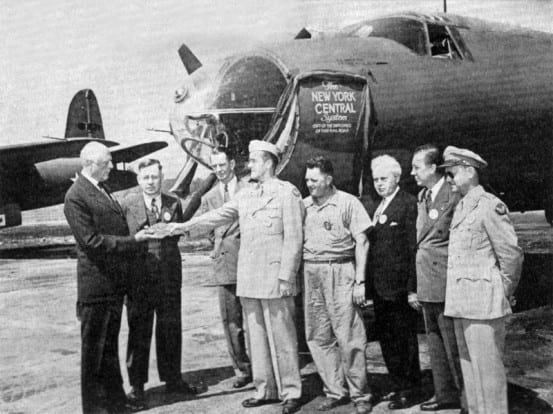
Dedication of the “New York Central System” bomber, attended by railroad president Frederick Williamson (left). Photo from the October 1942 issue of the Central Headlight.
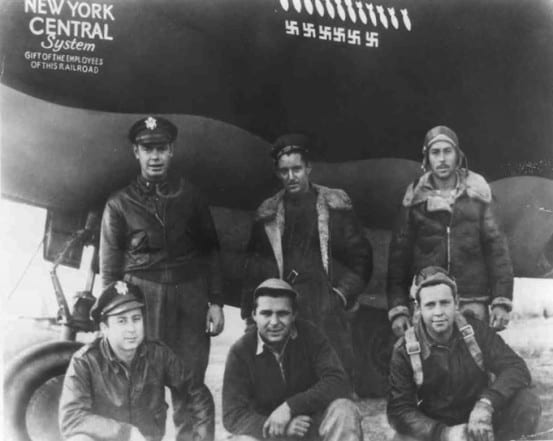
The first New York Central-sponsored plane. Photo courtesy b26.com.
The New York Central’s first twin-engine bomber, named simply “The New York Central System” was purchased with the funds raised by the railroad and its employees – $170,062.06 in total, money delivered on April 2, 1942 to the US Treasury. The idea was conceived by the employees of the Electric Locomotive shop in Collinwood, Ohio, who proposed small paycheck deductions from willing participants in order to fund the purchase. Nearly 90% of the Central’s workforce donated to this and other wartime fundraisers. Sadly, the bomber was shot down in February 1943 over North Africa after only 13 missions. However, determined railroad employees decided to raise further funds and purchased a replacement bomber, which was named the “New York Central II.” Though it was not unheard of for a group to sponsor a plane, this was the first time a group had come together a second time to purchase a replacement after the first’s loss.
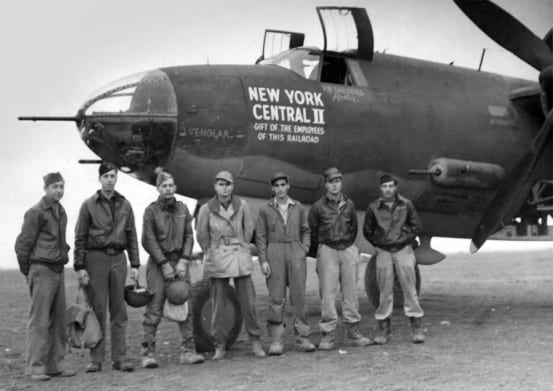
The “New York Central II” – ground crew member and furloughed New York Central employee Anthony Gibbs is at left.
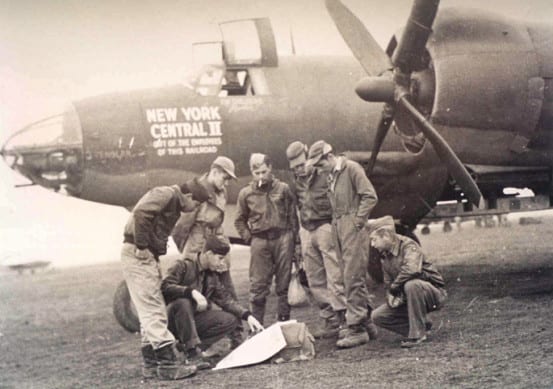
New York Central II crew briefing. Photo courtesy b26.com.
The replacement bomber had a far longer history, running 103 missions before being shot down. Updates on its status were frequently sent and published in the railroad’s magazine by Anthony Gibbs, furloughed NYC employee and member of the ground crew that serviced the bomber (he was also the son of John Gibbs, an electrician at Harmon). The New York Central II’s first mission was over Italy as part of the Battle of Monte Cassino, and her last was over Winnweiler, Germany on January 1st, 1945 after being shot down by anti-aircraft fire. In total, the New York Central II flew 410 operational combat hours, and dropped 322,000 pounds of bombs on Axis targets across Italy, France, and Germany.
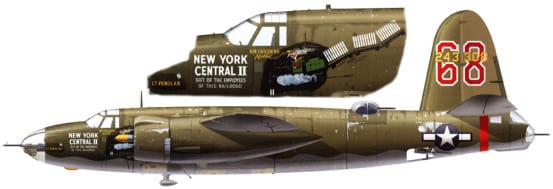
Illustration of the “New York Central II” by Mark Styling. The runaway train is an embellishment by the artist.
Witnesses that saw the shoot-down of the plane also saw at least four crew members bail out, and thus it was hoped that at least some of the crew had survived.
I first observed plane no. 68 when fire broke out on the left side of the ship, while the plane was still in the formation. It broke away to the left of the formation in a gradual glide. I saw two men leave the rear of the plane in rapid succession while the plane was at 10,000 feet just after it broke formation. Then seconds later a third man left the rear of the ship at an altitude of about 10,000 feet. Five seconds later a 4th man left the ship. I observed flame in front of this man when he bailed out but I cannot say if his chute was afire or not, or just what was burning. The flame lasted for 3 or 4 seconds and went out, after which time I lost sight of the ship and the 4 men who bailed out. I only observed the chutes of the first two men who bailed out to open. The last two I did not observe.
The plane stayed in a dive until it reached an altitude of about 3000 feet. At this altitude the plane went into a steep dive and spiraled to the ground. At 1300 hours the plane crashed at Fischbach near Pirmasens.
–Statement from 2nd Lt Joseph H. Herbert, Air Corps, 37th Bomb Squadron
Pilot Joseph Thomas Schoeps and Co-Pilot Hugh S. Teitsworth, Jr. were both killed, along with bombardier Camillo W. Tensi, and navigators Edward J. Purdy and Thomas F. Rawson. Schoeps was eventually laid to rest in Arlington National Cemetery, Teitsworth, Purdy, and Rawson were buried in the Lorraine American Cemetery in France. Engineer Gunner Arlyn L. Lones survived the crash, but was immediately executed by the Nazis upon landing. He was buried in Andrew Johnson National Cemetery, in Greeneville, TN. Radio Gunner Jimmie A. Reesha and Armorer Gunner Gerald R. Draper both survived and were brought to POW camps.
Draper was held for over a year, originally at Stalag Luft 3 but was later marched west after that camp’s impending liberation. Reesha was held for several months at Stalag XIII-D, until it was liberated by the US Army. Both men lived long lives after their service, passing away in 2006 and 1997, respectively. Whether they rode the New York Central’s trains after their return remains unknown.
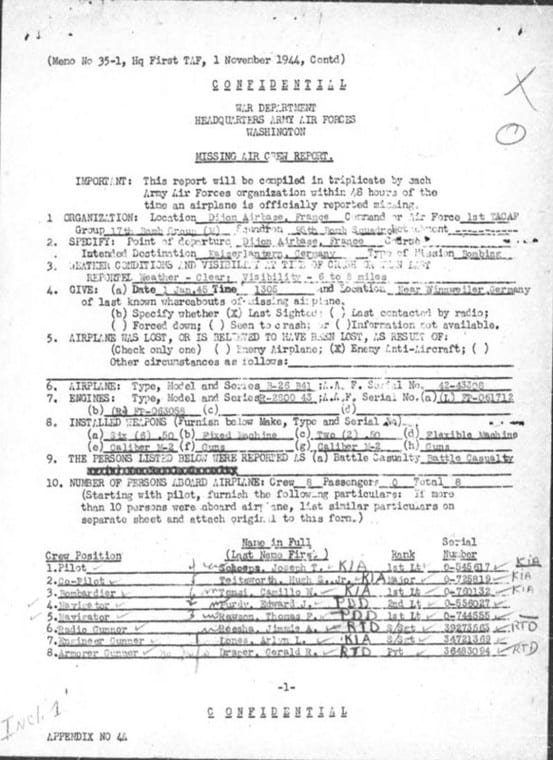
Missing Air Crew Report for the New York Central II
Special thanks to CanadaSouthern.com, whose archive of New York Central Headlight magazines was integral to the research on this subject.

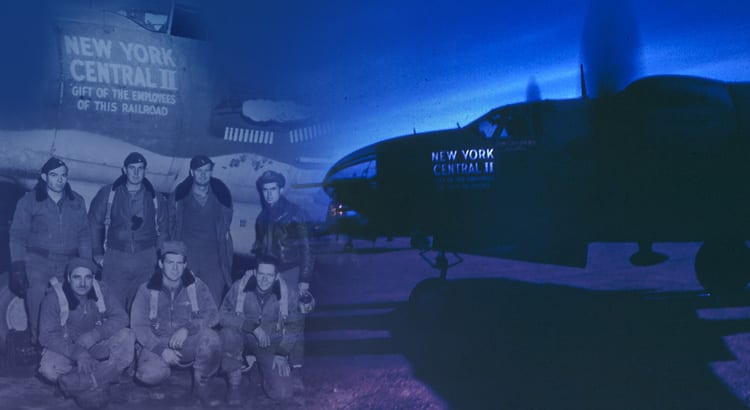
Awesome research. I had no idea of NYC employee sponsorship. I continue to be impressed by the initiative and hard work of that generation of Americans, my parents generation. The B26 was very good aircraft but required better than average piloting skills due to characteristics inherent in high performance twin engine craft. With it’s short wing span it had unique glide characteristics and was extremely responsive.
January 1, 1945 was the middle of the last German offensive strike in the west (Battle of the Bulge) and the outcome was still to be determined. Execution of crew members shows the impunity of the Nazis. Further ass-whipping would be required.
If one of the crew members was held for over a year in a prison camp and the missing crew report is dated November 1944, I believe the 1945 date is a typo. January 1944 would have been well before the landings at Normandy.
my father was John D Venglar of the NYCentral II
The train nose art was a squadron addition. The ‘loads’ on the cars were tally markings. Normally a mark would be added after every mission.
my father (Horace Johnson) was on the new york central bomber as a gunner, any info or pictures would be appropriated
appreciated, sorry auto spell